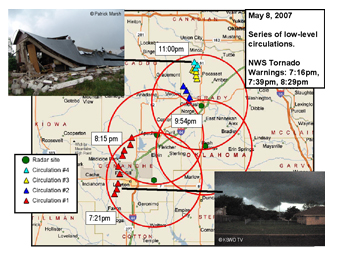Tornado Alley:
CASA's Adaptive Radar Network in “Tornado Alley" demonstrates DCAS capabilities during Spring Storm Season and DOE CLASIC experiments

2007 was an extremely active and successful first year of full operation for CASA’s four-node “end-to-end” system test bed in “tornado alley” southwestern Oklahoma. The test bed was used in two major experiments:(i) a 9-week 24/7 observational “spring” experiment in April and May 2007, (ii) as a platform providing supplemental observations to the Cloud and Land Surface Interaction Campaign (CLASIC) in collaboration with DOE’s Atmospheric Radiation Measurement (ARM) program. During the spring experiment, two particularly severe weather events (including tornadic activity within the test bed’s footprint) demonstrated the test bed’s end-to-end system capability to perform distributed collaborative, adaptive sensing of the atmosphere (DCAS); including end-user evaluations and a demonstration of direct end-user impact. In the CLASIC experiments, system functionality was significantly extended to include higher elevation scans and longer distance measurement. These experiments provide essential insights to help understand how the dense radar networks being developed in CASA can supplement – or perhaps replace – the large radar networks in use in the civil safety infrastructure today.
|